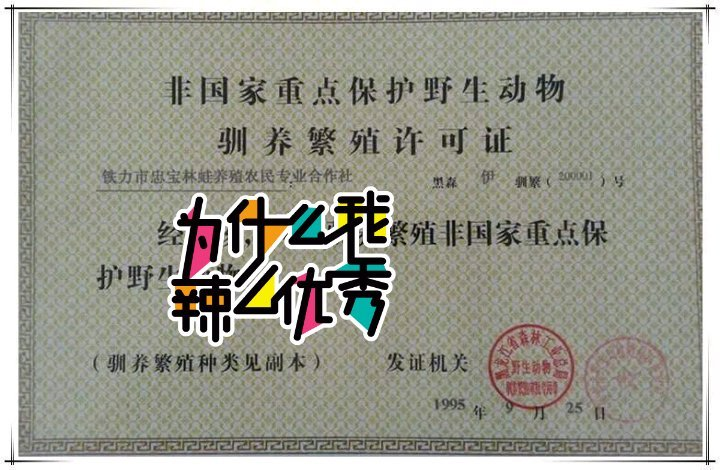Not long ago, CCTV launched the program "Don't Hurt Me Again: A Confession of Ten Wild Animals". Among them, there was a chapter dedicated to wood frog, which triggered discussions on wood frog related issues.
The first thing to ask is whether the amphibian wood frog is a terrestrial wildlife? The answer is yes.
From the perspective of the National Forestry and Grassland Administration, or the Ministry of Agriculture, they are classified as terrestrial wildlife to manage, and from the perspective of wood frog's life history assessment, they are also terrestrial wildlife.
Well, the document of the NPC Standing Committee's decision on a comprehensive ban on wild animals is also applicable to wood frog. The "Decision" clearly stipulates that the consumption of "terrestrial wildlife of important ecological, scientific and social value" as well as other terrestrial wildlife, including artificially bred terrestrial wildlife, protected by the state is prohibited. It is forbidden to hunt, trade and transport terrestrial wild animals that grow and reproduce naturally in the wild for the purpose of food.
During the COVID-19 epidemic, after the National People ’s Congress banned the consumption of wildlife, the major merchants of wood frogs in Yichun, Heilongjiang Province, still peddling Northeast wood frogs through some social media applications.
After investigation by environmental protection volunteers, it was found that most of these farmers are breeding in areas with good ecology, such as state-owned forest areas, nature reserves, etc., because this is also an area with complete ecosystems such as streams and rivers, and areas with little human disturbance. Farmers mostly use natural furrows and ponds for breeding. These farmers are also divided into commodity farmers and retail farmers. Commodity farmers have their own bases and incubation ponds to provide seedlings. Most of the farmers directly contract the ravines. In the form of cooperatives, the wood frogs received by the individual farmers are responsible for the subsequent industry chain finishing.
A survey focusing on the wood frog habitat found that most of the farmers who contracted forest land were in semi-manual farming mode. The worst phenomenon is to breed wood frogs in the core area of national nature reserves. In fact, what they call a breeding farm is to place frog eggs in natural forests, and then catch them when they mature.
A closer look at the wood frog commodity farmers in Northeast China
In 2018, CCTV News reported the hunting of wood frogs in Yichun, Heilongjiang.In 2019, CCTV reported that the wood frogs were cultivated in the core area of Jichun Hunchun National Nature Reserve, and Heilongjiang and Jilin increased the regulation and supervision.
Especially in Heilongjiang, the province has issued documents, regardless of whether or not they have a permit, forest frog farmers must conduct a comprehensive cleanup and rectification, and they must not resume farming within three years. This move angered several wood frog commodity farmers. They jointly petitioned the farmers to put pressure on the government, and then set up a forum on their own. They asked experts in the province to help propagate and appeal to various places, claiming that they were not hunting wild wood frogs; frog eggs were released every spring and go to the mountains and harvested the wood frogs that grew up in the fall. They spent huge amounts of capital investment and led local farmers to increase their income and become rich. They wanted to use this to occupy the high ground of public opinion.
This includes a person with a net name of " Chinese Forest Frog Prince" who has always posted his posts and instigated farmers in WeChat groups. Upon investigation, his Weibo profile showed that Tieli City Zhongbao Forest Frog Breeding Farmers Professional Cooperative. This needs to go back to a CCTV show in 2018. The location exposed in the program is Tieli City, Yichun, Heilongjiang. The program mentioned that Tieli Forestry illegally contracted the forest land to the villagers and charged the contract fee for breeding wood frogs. It is important to see clearly that the cultivation of wood frogs generally does not have a breeding license in the local area, because in recent years Heilongjiang Province has no longer issued such domestication and breeding licenses, and “acting” a contract as breeding license. The "Chinese Forest Frog Prince" does have a license, which is linked to the sale of products on the Internet. It shows that it was issued by the relevant department in Heilongjiang in 1995. 25 years have passed, and the policies and regulations have changed greatly.
After the broadcast of the CCTV program in 2018, Heilongjiang Tieli Forestry Bureau responded to CCTV's exposure to the problem of capturing wood frogs, and established an investigation team to conduct a thorough investigation, stating that the problems reported by CCTV, Tieli Forestry Bureau will carry out the comprehensive investigation and further investigation and verification. Once found, the personnel and units that violated the law and regulations were investigated to the end, and they were dealt with seriously and never tolerated. At the same time, it will also learn from the others and strengthen inspections of warning education and law enforcement supervision to ensure that similar problems never occur. With such a statement, is it really resolved?

(Photo source: Internet)
Original Chinese article:
http://www.cbcgdf.org/NewsShow/4854/11823.html
